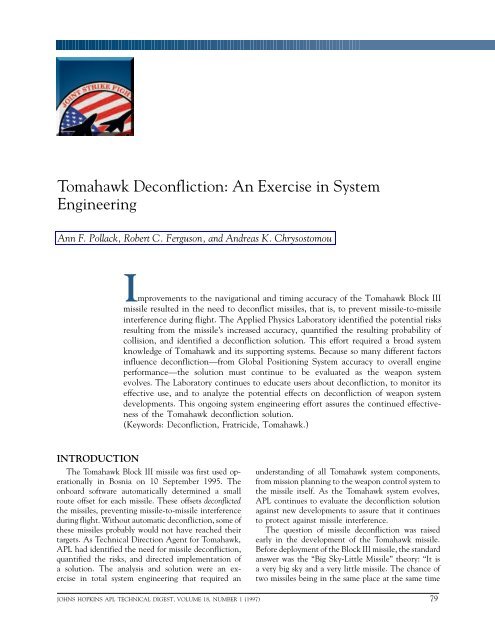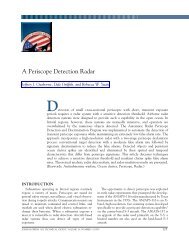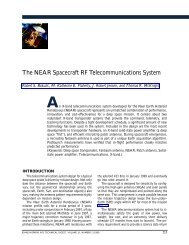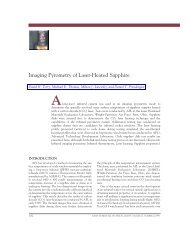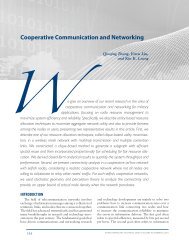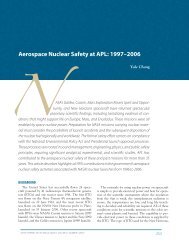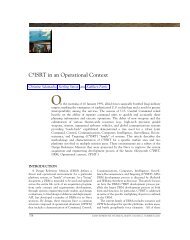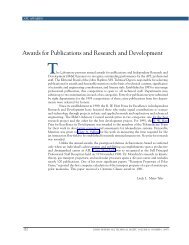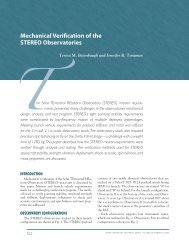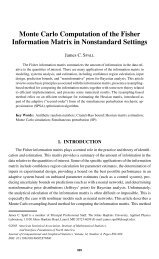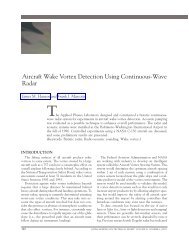Tomahawk Deconfliction - The Johns Hopkins University Applied ...
Tomahawk Deconfliction - The Johns Hopkins University Applied ...
Tomahawk Deconfliction - The Johns Hopkins University Applied ...
Create successful ePaper yourself
Turn your PDF publications into a flip-book with our unique Google optimized e-Paper software.
TOMAHAWK DECONFLICTION<br />
<strong>Tomahawk</strong> <strong>Deconfliction</strong>: An Exercise in System<br />
Engineering<br />
Ann F. Pollack, Robert C. Ferguson, and Andreas K. Chrysostomou<br />
Improvements to the navigational and timing accuracy of the <strong>Tomahawk</strong> Block III<br />
missile resulted in the need to deconflict missiles, that is, to prevent missile-to-missile<br />
interference during flight. <strong>The</strong> <strong>Applied</strong> Physics Laboratory identified the potential risks<br />
resulting from the missile’s increased accuracy, quantified the resulting probability of<br />
collision, and identified a deconfliction solution. This effort required a broad system<br />
knowledge of <strong>Tomahawk</strong> and its supporting systems. Because so many different factors<br />
influence deconfliction—from Global Positioning System accuracy to overall engine<br />
performance—the solution must continue to be evaluated as the weapon system<br />
evolves. <strong>The</strong> Laboratory continues to educate users about deconfliction, to monitor its<br />
effective use, and to analyze the potential effects on deconfliction of weapon system<br />
developments. This ongoing system engineering effort assures the continued effectiveness<br />
of the <strong>Tomahawk</strong> deconfliction solution.<br />
(Keywords: <strong>Deconfliction</strong>, Fratricide, <strong>Tomahawk</strong>.)<br />
INTRODUCTION<br />
<strong>The</strong> <strong>Tomahawk</strong> Block III missile was first used operationally<br />
in Bosnia on 10 September 1995. <strong>The</strong><br />
onboard software automatically determined a small<br />
route offset for each missile. <strong>The</strong>se offsets deconflicted<br />
the missiles, preventing missile-to-missile interference<br />
during flight. Without automatic deconfliction, some of<br />
these missiles probably would not have reached their<br />
targets. As Technical Direction Agent for <strong>Tomahawk</strong>,<br />
APL had identified the need for missile deconfliction,<br />
quantified the risks, and directed implementation of<br />
a solution. <strong>The</strong> analysis and solution were an exercise<br />
in total system engineering that required an<br />
understanding of all <strong>Tomahawk</strong> system components,<br />
from mission planning to the weapon control system to<br />
the missile itself. As the <strong>Tomahawk</strong> system evolves,<br />
APL continues to evaluate the deconfliction solution<br />
against new developments to assure that it continues<br />
to protect against missile interference.<br />
<strong>The</strong> question of missile deconfliction was raised<br />
early in the development of the <strong>Tomahawk</strong> missile.<br />
Before deployment of the Block III missile, the standard<br />
answer was the “Big Sky-Little Missile” theory: “It is<br />
a very big sky and a very little missile. <strong>The</strong> chance of<br />
two missiles being in the same place at the same time<br />
JOHNS HOPKINS APL TECHNICAL DIGEST, VOLUME 18, NUMBER 1 (1997) 79
A. F. POLLACK, R. C. FERGUSON, AND A. K. CHRYSOSTOMOU<br />
is too small to worry about.” This theory was not based<br />
on formal analysis, but rather on a sense that the navigational<br />
and timing uncertainties of the missile made<br />
collision unlikely. Relatively few <strong>Tomahawk</strong>s were<br />
deployed in the Fleet, and use of large numbers of<br />
<strong>Tomahawk</strong>s in a single strike was not considered a likely<br />
scenario. <strong>The</strong> limited numbers and the large uncertainties<br />
made missile interference extremely unlikely.<br />
As the <strong>Tomahawk</strong> system matured, the number of<br />
missiles in the Fleet rose. Tactical use of the <strong>Tomahawk</strong><br />
during Desert Storm in 1991 showed large numbers of<br />
<strong>Tomahawk</strong>s employed on relatively few routes. Subsequently,<br />
the Block III missile greatly reduced the navigation<br />
and timing uncertainties with Global Positioning<br />
System (GPS) navigation and time-on-target<br />
(TOT) control (which adjusts speed during flight so<br />
that the missile arrives at the target at a specified time).<br />
Improved accuracy and increased missile numbers<br />
raised concerns over potential missile-to-missile interference.<br />
At APL, we set out to determine when missiles<br />
might interfere with one another, to quantify the probability<br />
of interference, and to develop a solution for<br />
deconflicting the missiles.<br />
DEVELOPMENT OF THE<br />
DECONFLICTION SOLUTION<br />
We began characterization of the interference potential<br />
by breaking the problem down into specific<br />
instances where missile interference could be a concern.<br />
As the list of potential areas of concern grew, it<br />
became clear that they were all related. Whenever<br />
multiple missiles are in the same area at approximately<br />
the same time, there is a potential for interference.<br />
Missions were examined from launch to impact. Risk<br />
of interference at launch was assessed as low, but terminal<br />
fratricide (damage to a missile from the blast<br />
effects of another missile) and en route interference (a<br />
missile-to-missile encounter during flight) required<br />
additional analysis. APL conducted separate analyses to<br />
quantify the probability of interference for each of these<br />
cases. When analysis indicated the need for missile<br />
deconfliction, APL proposed a solution, which was<br />
quickly implemented by McDonnell Douglas and delivered<br />
to the Fleet. As the <strong>Tomahawk</strong> Weapons System<br />
continues to evolve, APL continues to monitor the<br />
system engineering impacts on the deconfliction solution’s<br />
effectiveness, including assessment of strikes into<br />
Iraq and Bosnia.<br />
Terminal Fratricide Analysis<br />
Initially, concern over missile interference focused<br />
on terminal fratricide caused by target debris, missile<br />
body debris, blast waves, or warhead fragments. Earlier<br />
studies 1 showed that blast wave effects and target debris<br />
have limited range, resulting in little or no opportunity<br />
to affect a trailing missile. Similarly, missile body debris<br />
is range-limited compared with the titanium warhead<br />
fragments. Because of their range, velocity, and ability<br />
to penetrate walls, these warhead fragments pose the<br />
most serious threat to a succeeding missile.<br />
Two basic considerations arise in the analysis of<br />
warhead fragment effects: How likely are the fragments<br />
to hit a trailing missile, and what is the resulting damage<br />
if a fragment-missile collision occurs? <strong>The</strong> APL<br />
analysis, described in the following paragraphs, showed<br />
that the probability of a missile being hit by warhead<br />
fragments is extremely small, even for small differences<br />
in TOT. Since these probabilities are so small, potential<br />
missile damage due to fragment impact was not addressed<br />
in detail.<br />
A closed-form expression for the probability of a<br />
fragment hitting a missile cannot be formed because of<br />
the nonlinear, nonuniform nature of the problem.<br />
Monte Carlo techniques, however, provide a method<br />
to estimate the probability of hit based on a particular<br />
set of scenarios. Scenario selection used a worst-case<br />
analysis based on the warhead fragmentation data from<br />
arena tests at the Naval Surface Warfare Center-China<br />
Lake. <strong>The</strong>se tests indicated that the fragmentation<br />
pattern for a <strong>Tomahawk</strong> Block III warhead is highly<br />
directional rather than uniform. Figure 1 shows the four<br />
worst-case scenarios used for analysis: (1) identical<br />
dive, (2) parallel dive, (3) opposite dive, and (4) opposite<br />
airburst. Each scenario has the trailing missile fly<br />
through the densest debris clouds. <strong>The</strong>se scenarios<br />
drive the warhead/missile simulation developed by<br />
APL.<br />
<strong>The</strong> warhead/missile simulation evaluates the probability<br />
of hit by modeling a fixed number of fragment<br />
trajectories from a single warhead detonation as a function<br />
of time. Random initial velocities and masses are<br />
selected for each fragment; then, depending upon the<br />
scenario, the trailing missile’s position and the positions<br />
of all fragments are computed. <strong>The</strong>se positions are<br />
compared over time to determine whether a hit occurs.<br />
To estimate the overall probability of hit, many different<br />
detonations were simulated. Each simulated detonation<br />
differed because of the randomness of each fragment’s<br />
initial velocity and mass. An estimate of the<br />
probability of hit was calculated as the ratio of the<br />
number of simulated detonations in which the missile<br />
was hit by at least one fragment to the total number<br />
of detonations.<br />
<strong>The</strong> results of repeated Monte Carlo simulations for<br />
each of the four scenarios are shown in Fig. 2, where<br />
the probability that a missile is hit by one or more<br />
fragments is plotted versus missile separation time. <strong>The</strong><br />
probability of hit is extremely small, even for modest<br />
TOT differences, because the fragments are widely<br />
80 JOHNS HOPKINS APL TECHNICAL DIGEST, VOLUME 18, NUMBER 1 (1997)
TOMAHAWK DECONFLICTION<br />
Scenario 1 Scenario 2<br />
Aim points separated by 100 ft<br />
Scenario 3 Scenario 4<br />
Same aim point for both missiles<br />
Same aim point for both missiles<br />
Figure 1. <strong>The</strong> four worst-case operational scenarios used for analysis of the potential for terminal fratricide (i.e., damage to a<br />
missile from the blast effects of another missile). Scenario 1, identical dive; scenario 2, parallel dive; scenario 3, opposite dive; and<br />
scenario 4, opposite airburst.<br />
dispersed very shortly after detonation and the missile<br />
is relatively small. <strong>The</strong> opposite dive scenario (scenario<br />
3) shows the highest probabilities because in this<br />
Probability of hit by at least one fragment<br />
0.05<br />
0.04<br />
0.03<br />
0.02<br />
0.01<br />
Scenario 1<br />
Scenario 2<br />
Scenario 3<br />
0 0 2 4 6 8 10<br />
Missile separation time (s)<br />
Probability of hit for<br />
scenario 4 < 0.005<br />
Figure 2. Results of Monte Carlo simulations for the terminal<br />
fratricide scenarios of Fig. 1, showing the probability of a hit by at<br />
least one fragment.<br />
scenario the missile passes through the densest fragment<br />
cloud. <strong>The</strong> probabilities for parallel dive (scenario<br />
2) are higher than those for identical dive (scenario 1),<br />
even though the trailing missile is further from the<br />
point of detonation, because a trailing missile in a<br />
parallel dive has a larger vulnerable surface area at all<br />
times. Opposite airburst (scenario 4) did not prove to<br />
be particularly vulnerable. For all scenarios, the probability<br />
of hit is less than 0.005 for missile separation<br />
times greater than 3 s.<br />
Although the analysis did not specifically address<br />
the effect of a hit on a trailing missile, the method just<br />
described can be slightly modified to estimate the probability<br />
of the trailing missile being hit by one or more<br />
heavy fragments. <strong>The</strong>se are the fragments most likely<br />
to damage or destroy the missile. To estimate the probability<br />
of hit by heavy fragments, the ratio of the total<br />
number of simulations in which the missile was hit by<br />
at least one heavy fragment to the total number of<br />
simulated detonations was computed. Any fragment<br />
weighing 0.5 lb or more is considered heavy. For all<br />
JOHNS HOPKINS APL TECHNICAL DIGEST, VOLUME 18, NUMBER 1 (1997) 81
A. F. POLLACK, R. C. FERGUSON, AND A. K. CHRYSOSTOMOU<br />
scenarios, the probability of hit by a heavy fragment is<br />
less than 0.005 for missile separation times greater than<br />
about 1.2 s.<br />
Overall, the probability of a missile being hit by<br />
debris from a previous missile impact is small. <strong>The</strong><br />
conclusions of this analysis indicate that terminal fratricide<br />
is not a concern for TOT separations greater<br />
than 3 s, a relatively small separation in comparison<br />
with variations in firing time and missile speed.<br />
En Route Interference Analysis<br />
Characterization of potential missile interference<br />
suggested that any time missiles were supposed to be in<br />
the same place at approximately the same time there<br />
was the potential for a collision. Since many missiles<br />
can share the same basic route to a single target or a<br />
set of targets, an analysis of the probability of collision<br />
along the flight path was necessary. <strong>The</strong> basic probability<br />
of en route collision was calculated in two parts:<br />
What is the probability that two missiles will pass, and<br />
what is the probability that two passing missiles will<br />
collide?<br />
<strong>The</strong> probability that missiles will pass depends on<br />
the missiles’ abilities to control their speeds. Each<br />
missile has a commanded speed; however, the actual<br />
speed flown by the missiles may vary. Two missiles will<br />
pass if the difference between their speeds is large<br />
enough. For missiles without TOT control, this speed<br />
difference can be represented by a Gaussian distribution<br />
with a mean of 0 and a standard deviation of<br />
2 speed , where speed is the standard deviation for an<br />
individual missile’s speed. This standard deviation is<br />
driven by variations in the missile’s air data system.<br />
Using this distribution, the probability of passing is the<br />
probability that the difference in missile speed will<br />
exceed some critical value. <strong>The</strong> critical value is determined<br />
by the initial missile separation and the nominal<br />
missile speed. <strong>The</strong> addition of TOT control to a mission<br />
changes the probability of passing. In effect, TOT<br />
control calibrates the missile speed at each waypoint,<br />
or turning point, eliminating the effects of the air data<br />
system variations. <strong>The</strong> probability of passing is significantly<br />
lower for missiles with unique TOT assignments<br />
that arrive on the common path in order; however,<br />
missiles that arrive out of order have a probability of<br />
passing that is close to 1 because the system will attempt<br />
to force a pass.<br />
<strong>The</strong> probability of collision while passing depends<br />
on the navigational accuracy of the missiles. If two<br />
missiles are flying along a common route and they pass,<br />
the difference in their relative accuracy determines<br />
whether they will collide. <strong>The</strong>se differences arise<br />
through a combination of guidance and control variations,<br />
GPS errors, and altimeter performance issues. 2,3<br />
As was the case for the speed distribution, these<br />
differences in missile position can be expressed as Gaussian<br />
distributions. A collision will occur if the differences<br />
between the missile locations in both the crosstrack<br />
and altitude dimensions are small enough. <strong>The</strong><br />
critical values for cross-track and altitude collisions<br />
must account for missile size, potential aerodynamic<br />
interference, and noninstantaneous passing. <strong>The</strong>se factors<br />
define the interference zones shown in Fig. 3; note<br />
that actual physical contact is not necessary for a<br />
collision to occur.<br />
Combining these results for the probability of passing<br />
and the probability of collision while passing produces<br />
a quantitative closed-form expression for the<br />
probability of two missiles without TOT control<br />
colliding (see Table 1). As demonstrated in every operational<br />
use of <strong>Tomahawk</strong>, more than two missiles may<br />
share a common route. APL built upon the two-missile<br />
equation to allow for analysis of an N-missile<br />
scenario—some number N of missiles flying a common<br />
route segment with an initial time separation of<br />
seconds between arrivals at the common route. <strong>The</strong><br />
N-missile probability of collision refers to the probability<br />
of at least one collision occurring.<br />
In developing the N-missile equation, the key observations<br />
are that every possible pair of missiles has<br />
some probability of collision, and the probability of at<br />
least one collision is simply 1 minus the probability that<br />
none of the missiles collide. Let p() represent the twomissile<br />
probability of collision for missiles initially<br />
spaced seconds apart. For the three-missile case, no<br />
collision will occur if missiles 1 and 2 do not collide<br />
Figure 3. Missile collision examples. Missile size, potential aerodynamic<br />
interference, and noninstantaneous passing define interference<br />
zones; actual physical contact is not necessary for a<br />
collision to occur.<br />
82 JOHNS HOPKINS APL TECHNICAL DIGEST, VOLUME 18, NUMBER 1 (1997)
TOMAHAWK DECONFLICTION<br />
Table 1. Equation for the probability of collision of two missiles without time-on-target control while the missiles are en<br />
route to the target.<br />
Parameter Symbol Equation or definition<br />
Two-missile probability of collision P C<br />
P p<br />
P CWP<br />
⌠<br />
exp ⎛ ⎞<br />
⎮<br />
x<br />
⎜−<br />
2 ⎟<br />
◆ Probability of passing P ⎮<br />
p<br />
⎝ 4speed<br />
⎠<br />
⎮<br />
dx<br />
⌡ 2<br />
<br />
∞<br />
2<br />
s r speed<br />
• Speed standard deviation speed<br />
Standard deviation of a single missile’s speed; depends<br />
on air data system and engine performance variations<br />
s<br />
2 c<br />
• Required speed differential for passing s r<br />
DCR<br />
− sc<br />
– Commanded speed s c<br />
Speed the missile is supposed to be flying; set in mission<br />
planning<br />
– Initial time separation Time interval between missile arrivals on the common<br />
route; depends on launch rate<br />
– Common route distance D CR<br />
Distance the missile routes share in common; depends<br />
on mission plans<br />
◆ Probability of collision while passing P CWP<br />
P AC<br />
P CTC<br />
⌠<br />
exp ⎛ 2<br />
x ⎞<br />
⎮ ⎜−<br />
2 ⎟<br />
• Probability of altitude collision P AC<br />
⎮ ⎝ 4alt<br />
⎠<br />
⎮<br />
dx<br />
⌡ 2<br />
<br />
– Critical height difference h c<br />
Maximum height difference when a missile collision will<br />
occur in the altitude dimension; depends on missile<br />
physical dimensions and aerodynamic effects<br />
– Altitude standard deviation alt<br />
Standard deviation of a single missile’s altitude; depends<br />
on altimeter variations<br />
hc<br />
−hc<br />
alt<br />
⌠<br />
exp ⎛ 2<br />
x ⎞<br />
⎮ −<br />
• Probability of cross-track collision P ⎜ 2 ⎟<br />
CTC ⎮ ⎝ 4ct<br />
⎠<br />
⎮<br />
dx<br />
⌡ 2<br />
<br />
– Critical cross-track difference x c<br />
Maximum width difference when a missile collision will<br />
occur in the cross-track dimension; depends on missile<br />
physical dimensions and aerodynamic effects<br />
– Cross-track standard deviation ct<br />
Standard deviation of a single missile’s cross-track<br />
position; depends on GPS and guidance and control<br />
errors<br />
xc<br />
−xc<br />
ct<br />
JOHNS HOPKINS APL TECHNICAL DIGEST, VOLUME 18, NUMBER 1 (1997) 83
A. F. POLLACK, R. C. FERGUSON, AND A. K. CHRYSOSTOMOU<br />
[1 p()], if missiles 2 and 3 do not collide [1 p()],<br />
and if missiles 1 and 3 do not collide [1 p(2)]. This<br />
produces the following three-missile probability of at<br />
least one collision:<br />
1 {[1 p()][1 p()][1 p(2)]} , (1)<br />
or, using the mathematical approximation for small p,<br />
1 p e p , the 3-missile probability of at least one<br />
collision can be expressed as<br />
1 e [2p() +p(2)] . (2)<br />
Adding a fourth missile adds three new pairs of missiles<br />
(one pair seconds apart, one pair 2 seconds apart, and<br />
one pair 3 seconds apart) for a probability of at least<br />
one collision of<br />
1 e [3p() +2p(2)+ p(3)] . (3)<br />
Generalizing this to an N-missile equation for the<br />
probability of at least one collision among N missiles<br />
without TOT control yields<br />
−∑<br />
P( N)<br />
= 1−e<br />
i=<br />
1<br />
c<br />
N−1<br />
( N−i) p( i)<br />
.<br />
(4)<br />
Once the analytical methodology was in place, we<br />
determined the appropriate fixed-input parameters for<br />
the <strong>Tomahawk</strong> missile system. <strong>The</strong>se included navigational<br />
accuracy, which is based on relative GPS performance<br />
and altimeter specifications, and the speed fluctuations<br />
that result from air data system variations.<br />
Other parameters, such as length of mission, number of<br />
missiles, and initial missile separation, were allowed to<br />
vary so we could investigate different scenarios. Figure<br />
4 shows, for a 600-nmi common route and initial<br />
missile separations of 10, 30, and 60 s, curves of the<br />
probability of collision versus the number of Block III<br />
missiles without TOT control. <strong>The</strong> probability of collision<br />
values are omitted due to classification; however,<br />
the values are exponential in the number of missiles,<br />
and probabilities reached into the double digits. For<br />
missiles on common routes flying without TOT control,<br />
deconfliction is clearly required.<br />
To examine the deconfliction requirements for missiles<br />
using TOT control, we used the same basic equations.<br />
<strong>The</strong> input parameter that changes is the probability<br />
of passing, which depends upon the assigned TOT<br />
of the missiles. Missiles with very closely spaced TOT<br />
assignments could pass each other multiple times en<br />
route to the target. As the difference in assigned TOT<br />
approaches zero, the probability of collision approaches<br />
Probability of collision<br />
0<br />
600-nmi common route<br />
5<br />
10<br />
Number of missiles<br />
15<br />
10 s<br />
30 s<br />
60 s<br />
Figure 4. <strong>The</strong> N-missile probability of at least one collision.<br />
(<strong>Tomahawk</strong> Block III without time-on-target control). Curves show<br />
the probability of at least one collision en route to the target with<br />
initial missile separations of 10, 30, and 60 s.<br />
1 for missiles with identical assigned TOT as the length<br />
of the common route increases. As the TOT separation<br />
increases, the probability of collision rapidly decreases<br />
because of TOT speed calibration. An additional twist<br />
occurs if missiles with unique TOT assignments arrive<br />
on a common route out of sequence (that is, the missile<br />
with the later TOT arrives on the common route first).<br />
In this case, the probability of passing is 1, since the<br />
missile software essentially forces a pass to achieve the<br />
assigned TOT. Thus, TOT control presents a more<br />
complex probability of collision picture, but the need<br />
for deconfliction measures remains clear.<br />
<strong>Deconfliction</strong> Solution and Implementation<br />
Our analysis of the probability of collision was initiated<br />
shortly before the Block III missile was scheduled<br />
to arrive in the Fleet. Terminal fratricide had originally<br />
been considered the most likely area of interference;<br />
the relatively high probabilities of collision shown by<br />
the en route analysis had not been anticipated. After<br />
briefing the <strong>Tomahawk</strong> community on the analysis and<br />
achieving a consensus that the potential for en route<br />
interference was indeed high, we set out to define a<br />
solution that could be provided to the Fleet in time for<br />
the arrival of the <strong>Tomahawk</strong> Block III missiles. Because<br />
time was short, we took a two-phase approach, limiting<br />
the initial phase to a procedural solution. In the second<br />
phase, a wider range of options was considered.<br />
Whenever multiple missiles are trying to be in the<br />
same place at the same time, there is a potential<br />
for interference. Any deconfliction solution must remove<br />
one or more of these elements. How can this<br />
be achieved procedurally? <strong>The</strong> number of missiles in a<br />
given strike is driven by tactical considerations—what<br />
the required damage to the target area is and how many<br />
missiles are necessary to achieve that level of damage.<br />
Changing the number of missiles would interfere<br />
with achieving the strike objectives. <strong>The</strong> remaining<br />
20<br />
84 JOHNS HOPKINS APL TECHNICAL DIGEST, VOLUME 18, NUMBER 1 (1997)
TOMAHAWK DECONFLICTION<br />
deconfliction options are to separate the missiles in<br />
space by using different routes or to separate the missiles<br />
in time by using launch spacing. Missiles on different<br />
routes cannot interfere with each other until they reach<br />
the target area, and the terminal fratricide analysis<br />
shows that the probability of interference in the target<br />
area is low. Creating an entirely separate mission for<br />
every missile launched, however, is not necessarily an<br />
option. Mission planning can be a time-consuming<br />
process, especially when a limited number of scenes are<br />
available for navigation updates. Separating missiles in<br />
time can also procedurally deconflict missiles. We<br />
developed a matrix of separation times required to<br />
deconflict different numbers of missiles for common<br />
routes of various lengths. <strong>The</strong> temporary procedural<br />
guidance issued to the Fleet advised a combination of<br />
spatial and temporal separation: it recommended use of<br />
multiple routes to reduce the number of missiles per<br />
route and use of time separation for those missiles<br />
remaining on a common route. TOT control was not<br />
addressed by the temporary guidance since it could not<br />
be used until after a subsequent weapon system upgrade,<br />
when the second-phase deconfliction solution would be<br />
in place.<br />
Although the temporary procedural solution provided<br />
adequate missile deconfliction, it was tactically<br />
undesirable. Large missile separations in the target area<br />
can increase vulnerability to threats and make coordination<br />
more difficult. Procedural deconfliction also<br />
imposed extra responsibilities on the mission planners<br />
and the Fleet. Four primary goals were used in developing<br />
the second phase of the deconfliction solution:<br />
• Reduce the probability of collision to acceptable<br />
levels for missions with and without TOT control.<br />
• Maintain full operational effectiveness.<br />
• Make the solution as transparent as possible for Navy<br />
personnel.<br />
• Contain the cost and schedule so that the tactically<br />
undesirable temporary guidance could be eliminated.<br />
Various solution options were developed and evaluated<br />
against these goals to determine their suitability for<br />
deconfliction.<br />
Several proposed solutions did not adequately reduce<br />
the probability of collision. Some solutions<br />
worked for missiles with TOT control but not for those<br />
without it, or vice versa. This category of solution<br />
included reducing air data system errors and calculating<br />
the ground speed using GPS. Other solutions were<br />
eliminated because they limited the operational effectiveness<br />
of the system. <strong>The</strong> need to maintain full operational<br />
effectiveness eliminated the large time separations<br />
imposed as a part of the procedural solution<br />
because of the potential increased vulnerability to<br />
threats. Other conceivable but less promising solutions,<br />
such as eliminating the use of GPS or decreasing GPS<br />
accuracy, were also ruled out because they limited<br />
operational effectiveness. Lack of transparency ruled<br />
out elimination of all common routes, because<br />
this solution would increase the workload of mission<br />
planners.<br />
After many solutions were eliminated because they<br />
did not satisfy the primary goals, the remaining options<br />
centered on inserting a small automatic route offset,<br />
thus putting missiles onto slightly different routes to<br />
reduce the probability of collision. To deconflict the<br />
entire mission, including the segment of the flight over<br />
water, these offsets had to be applied either in the<br />
weapon control system or in the missile flight software.<br />
<strong>The</strong> decision between these two options centered on<br />
cost and schedule. <strong>The</strong> flight software is distributed<br />
with the mission library and downloaded onto the<br />
missile just prior to launch. A change to this software<br />
would therefore reach all <strong>Tomahawk</strong> shooters relatively<br />
quickly. <strong>The</strong> weapon control systems are updated much<br />
less frequently, and the change is put into the Fleet<br />
gradually as ships are upgraded. In addition, updating<br />
the weapon control system would require a change to<br />
both the surface ship and the submarine weapon control<br />
systems, increasing the overall cost. After consideration<br />
of all the possible deconfliction options, we<br />
determined that the option that best satisfied the goals<br />
of deconfliction, operational effectiveness, transparency,<br />
and cost/schedule was inserting a small route offset<br />
using the missile flight software.<br />
After selection of the general deconfliction solution,<br />
many details remained to be worked out. How many<br />
offsets should there be, and how far apart should they<br />
be spaced to achieve the optimum reduction in the<br />
probability of collision? Would these offsets affect the<br />
missile probability of clobber (colliding with the<br />
ground) or the probability of update (achieving a navigation<br />
fix)? When should the offsets be inserted and<br />
removed from the flight path? What is the effect of<br />
TOT control? How should the missiles be assigned to<br />
offsets? APL developed several Monte Carlo simulations<br />
to help answer these questions.<br />
Analysis began with assigning offsets to missiles. To<br />
consolidate the solution within the flight software and<br />
avoid placing new requirements on the operators, offset<br />
assignment had to be distributed, with each missile<br />
selecting its offset independently. Given a distributed<br />
assignment scheme, offset selection could be either<br />
random or deterministic. Random assignment offers<br />
the advantage of a simple distributed implementation.<br />
Distributed deterministic assignment is more difficult<br />
to implement, but can provide better performance than<br />
a random scheme. Preliminary analysis indicated that<br />
a random assignment algorithm would not sufficiently<br />
reduce the probability of collision, so efforts focused on<br />
developing a deterministic assignment scheme.<br />
JOHNS HOPKINS APL TECHNICAL DIGEST, VOLUME 18, NUMBER 1 (1997) 85
A. F. POLLACK, R. C. FERGUSON, AND A. K. CHRYSOSTOMOU<br />
Deterministic missile offset assignment is simple in<br />
a centralized scheme. Information is available about all<br />
of the missiles so they can be assigned unique offsets.<br />
In a distributed scheme, information is much more<br />
limited. Each missile must independently select an<br />
offset without knowing the number of missiles sharing<br />
the route. After considering the information available<br />
to each missile, the assignment scheme focused on the<br />
launch time and launch location. <strong>The</strong> minimum separation<br />
between missile launch times for a single shooter<br />
defines a time interval. A set of these time intervals<br />
is associated with each missile offset in a repeating<br />
pattern. <strong>The</strong> minimum separation between missiles<br />
from the same shooter sharing an offset is equal to the<br />
number of intervals multiplied by the time interval.<br />
Thus, the launch time deconflicts missiles from a single<br />
shooter. When multiple shooters are involved in a<br />
strike, the possibility exists for simultaneous missile<br />
firings. To prevent these missiles from sharing the same<br />
offset, the placement of the initial offset depends upon<br />
launch platform location. This randomizes offset selection<br />
between different shooters, reducing the probability<br />
of two closely spaced missiles sharing an offset.<br />
Monte Carlo simulations indicate that this distributed<br />
deterministic allocation algorithm can achieve the<br />
required reduction in probability of collision.<br />
<strong>The</strong> probability of collision reduction depends upon<br />
the size and number of offsets. To avoid increasing the<br />
probability of missile clobber, the overall width of the<br />
cross-track corridor is limited by the size of the mission<br />
planning analysis corridor. <strong>The</strong> conservative mission<br />
planning analysis corridor analyzes more ground for<br />
probability of clobber than is required for GPS accuracy.<br />
This additional analyzed terrain is used for crosstrack<br />
offsets, thereby maintaining the overall probability<br />
of clobber. Vertical offsets involve a trade-off<br />
between probability of collision and missile survivability.<br />
Simulations demonstrated that a relatively small<br />
vertical offset can dramatically reduce the probability<br />
of collision. <strong>The</strong> impact on missile survivability is<br />
minimal since vertical offsets are small and are removed<br />
before the missile reaches the terminal area where<br />
heavy defenses are most likely. Only positive vertical<br />
offsets are used, resulting in increased altitude that<br />
maintains or reduces the probability of clobber.<br />
Once the overall size of the corridor available for<br />
offsets is fixed, the number of cross-track and vertical<br />
offsets must be determined. A Monte Carlo simulation<br />
was developed to analyze the probability of collision for<br />
different numbers of offsets based on different scenarios.<br />
<strong>The</strong> scenario definition included setting the number of<br />
missiles, number of launch platforms, and platform<br />
firing rates. Based on simulation results, a grid of<br />
seven cross-track offsets by three vertical offsets was<br />
established.<br />
Offset insertion and removal is influenced by the<br />
probability of collision and the probability of navigation<br />
update. Since GPS accuracy is responsible for the<br />
increased probability of collision, the offset is inserted<br />
upon GPS acquisition. To avoid reducing the missile’s<br />
chance of achieving a navigation fix, the offsets are<br />
removed before the first Digital Scene Matching Area<br />
Correlator (DSMAC) scene is used. For missions without<br />
DSMAC, the offsets are removed before the target<br />
area is reached.<br />
A final consideration involves the impact of TOT<br />
control on deconfliction. TOT control allows a missile<br />
to control its speed during flight to arrive at the target<br />
at a specified time. If multiple missiles are trying to be<br />
in the exact same place at the exact same time, especially<br />
for long distances, the probability of collision is<br />
high. <strong>The</strong> en route offsets help to prevent collision<br />
during most of the flight; however, the offsets must be<br />
removed in the terminal area before the target is<br />
reached. If the missiles are aimed at the same point, the<br />
only possible method of deconfliction is assigning the<br />
missiles a TOT separation. Minimizing the size of<br />
the separation is critical to maintaining <strong>Tomahawk</strong>’s<br />
tactical flexibility. <strong>The</strong> minimum required separation is<br />
based on TOT control accuracy, potential aerodynamic<br />
interactions, engine performance differences, target<br />
area considerations, and the possibility of terminal<br />
fratricide.<br />
<strong>The</strong> second-phase deconfliction solution was implemented,<br />
tested, and delivered to the Fleet less than a<br />
year after the deconfliction analysis was started, and the<br />
solution achieved all four primary goals. It met the cost<br />
and schedule containment goals, and deconfliction<br />
using automatic missile operational flight software<br />
enabled very simple guidance (Fig. 5) that minimized<br />
the effect on operators and maintained full operational<br />
effectiveness. Analysis of the solution reveals that the<br />
deconfliction measures installed in the Fleet reduce the<br />
probability of collision by an order of magnitude, returning<br />
it to the levels of the <strong>Tomahawk</strong> Block II<br />
missile, when the Big Sky-Little Missile theory was<br />
adequate. <strong>The</strong> solution thus reduced collision probabilities<br />
to acceptable levels.<br />
CONTINUED DECONFLICTION<br />
EFFORTS<br />
As Technical Direction Agent for <strong>Tomahawk</strong>, APL’s<br />
work extends beyond the initial delivery of an analysis,<br />
product, or solution. Part of our responsibility is to<br />
continue to monitor the evolution of the <strong>Tomahawk</strong><br />
weapon system to assure that all the pieces continue to<br />
work together properly. Because APL is involved with<br />
the system at so many different levels, we have a unique<br />
perspective on <strong>Tomahawk</strong>, enabling us to identify<br />
86 JOHNS HOPKINS APL TECHNICAL DIGEST, VOLUME 18, NUMBER 1 (1997)
Common<br />
route?<br />
Yes<br />
Less<br />
than<br />
20 missiles?<br />
No<br />
(>20)<br />
Reallocate<br />
missiles/<br />
plan more<br />
missions<br />
No<br />
Yes<br />
(100 ft)<br />
Aim point<br />
separation<br />
A. F. POLLACK, R. C. FERGUSON, AND A. K. CHRYSOSTOMOU<br />
indicated that the automatic offset algorithm assigned<br />
all missiles to unique offsets during the en route portion<br />
of the mission.<br />
In addition to monitoring the effective implementation<br />
of the deconfliction solution in the current system,<br />
APL also evaluates the implications of potential<br />
future developments in the <strong>Tomahawk</strong> missile system.<br />
One improvement being considered is use of GPS after<br />
the missile’s final DSMAC navigation update. Post-<br />
DSMAC use of GPS allows missions to be planned with<br />
longer distances between the final DSMAC scene and<br />
the target by dramatically reducing the effects of the<br />
navigator drift rate. Because the analysis of the probability<br />
of collision includes a component dependent on<br />
both the terminal length and terminal accuracy, post-<br />
DSMAC GPS has the potential to affect the deconfliction<br />
solution. APL determined the changes resulting<br />
from post-DSMAC GPS and input the changes into<br />
the deconfliction simulations to quantify the effect on<br />
the probability of collision. This analysis showed that<br />
despite a small increase, the overall probability of collision<br />
remained within acceptable limits.<br />
Tactical changes can also require deconfliction to be<br />
re-examined. To help reduce the number of missiles on<br />
a common route, the mission planners started to add<br />
altitude offsets to certain missions. A question arose<br />
about whether or not wake effects from the stacked<br />
missiles were a concern. Although aerodynamic effects<br />
were considered during the initial analysis, APL undertook<br />
a more detailed examination to answer the Fleet’s<br />
question. A simulation was developed to determine the<br />
probability of a missile encountering the wake field of<br />
a previous missile. <strong>The</strong>se results were fed into a second<br />
multimissile simulation to determine the overall probability<br />
within the context of a strike. <strong>The</strong> results indicated<br />
that, although a wake encounter is possible, such<br />
encounters are relatively rare. Additional analysis with<br />
a 6 degree-of-freedom simulation further indicated that<br />
the <strong>Tomahawk</strong> missile is capable of recovering from<br />
certain wake encounters. <strong>The</strong> conclusion was that no<br />
additional deconfliction measures were necessary.<br />
As new system modifications occur, APL will continue<br />
its system engineering efforts with regard to<br />
<strong>Tomahawk</strong> deconfliction. System engineering does not<br />
stop with the delivery of the initial solution. As<br />
<strong>Tomahawk</strong> evolves, deconfliction must evolve with it<br />
to assure a low probability of collision.<br />
CONCLUSIONS<br />
<strong>The</strong> Big Sky-Little Missile theory was widely accepted<br />
when APL began its deconfliction analysis. While<br />
initially valid, the theory was based on an earlier system<br />
and needed to change to fit new system developments.<br />
APL’s systematic approach to deconfliction identified<br />
and analyzed the key areas of concern. Many considered<br />
the target area, dense with arriving missiles and explosive<br />
debris, the most likely area for interference, but our<br />
analysis showed such terminal fratricide was not a<br />
major concern. En route interference was considered<br />
unlikely, in part because of the Big Sky Little Missile<br />
theory. Our analysis demonstrated that GPS guidance<br />
significantly reduces the “size of the sky,” leading to<br />
unacceptable probabilities of collision without some<br />
form of deconfliction. After building a consensus within<br />
the <strong>Tomahawk</strong> community supporting the need for<br />
deconfliction, APL took the lead in identifying and<br />
evaluating solutions. Potential solutions ranged from<br />
changes in mission planning to changes in weapon<br />
control to changes in the missile itself. APL’s broad<br />
system perspective enabled us to recommend a solution<br />
from among the diverse set of options. We provided the<br />
analysis to define the details necessary for implementation<br />
and followed the solution through development<br />
and testing all the way into tactical Fleet deployment.<br />
<strong>The</strong> Laboratory’s deconfliction involvement did not<br />
end with delivery of the solution. <strong>Deconfliction</strong> is a<br />
complex system problem. Delivery of the initial solution<br />
to the Fleet was just one step in addressing deconfliction.<br />
As the <strong>Tomahawk</strong> missile system continues to<br />
evolve, APL continues to assess how these changes<br />
affect deconfliction. APL provides continuity and<br />
breadth of knowledge to the <strong>Tomahawk</strong> program that<br />
enable us to identify and track issues, such as deconfliction,<br />
that reflect total system capabilities.<br />
REFERENCES<br />
1 Southwest Research Institute, Building Debris Hazard Prediction Model, Final<br />
Report (Feb 1991).<br />
2 U.S. Department of Commerce, <strong>The</strong> Navstar GPS System, AD-A199 829 (Sep<br />
1988).<br />
3 Critical Item Product Function Specification for the Radar Altimeter, JCM-1962.<br />
88 JOHNS HOPKINS APL TECHNICAL DIGEST, VOLUME 18, NUMBER 1 (1997)
TOMAHAWK DECONFLICTION<br />
THE AUTHORS<br />
ANN F. POLLACK joined APL after receiving a Bachelor of Engineering<br />
Science degree in electrical engineering and a Master of Science in Engineering<br />
degree in computer science from <strong>The</strong> <strong>Johns</strong> <strong>Hopkins</strong> <strong>University</strong> in 1988. In 1991<br />
she received an M.S. in electrical engineering, also from <strong>Johns</strong> <strong>Hopkins</strong>, and she<br />
is currently pursuing a Ph.D. in computer science from the <strong>University</strong> of<br />
Maryland Baltimore County. Ms. Pollack is a senior engineer in the Strike<br />
Warfare Systems Engineering Group of APL’s Power Projection Systems<br />
Department. She has worked primarily on the <strong>Tomahawk</strong> program, performing<br />
a variety of systems engineering tasks; she is lead engineer for <strong>Tomahawk</strong><br />
deconfliction. Her other projects include Naval Surface Fire Support<br />
(NSFS), the Joint Maritime Command Information System (JMCIS), and<br />
the Cooperative Engagement Capability (CEC). Her e-mail address is<br />
Ann.Pollack@jhuapl.edu.<br />
ROBERT C. FERGUSON received a B.S. in electrical engineering from Cornell<br />
<strong>University</strong> in 1984 and an M.S. in electrical engineering from Purdue <strong>University</strong><br />
in 1985. He joined APL in 1986 as a member of the Strategic Systems<br />
Department, where he contributed to Trident II missile accuracy analysis. In<br />
1989, he joined the Power Projection Systems Department, developing algorithms<br />
for the Aegis Anti-Air Warfare Correlator/Tracker and performance<br />
system analysis for the <strong>Tomahawk</strong> Baseline Improvement Program. Mr. Ferguson<br />
has also participated in <strong>Tomahawk</strong> deconfliction analysis and in data fusion<br />
efforts for the E-2C aircraft. His recent efforts have involved distributed<br />
interactive simulation algorithm development and analysis for the Precision<br />
Integrated Strike Concept Evaluation Suite (PISCES) and the Joint Precision<br />
Strike Demonstration (JPSD) programs. Currently, he is involved in algorithm<br />
development and analysis efforts for the Standard Missile Block IVA program.<br />
His e-mail address is Robert.Ferguson@jhuapl.edu.<br />
ANDREAS K. CHRYSOSTOMOU is a member of APL’s Principal Professional<br />
Staff and supervisor of the Data Fusion Section of the Strike Warfare Systems<br />
Engineering Group in APL’s Power Project Systems Department. He holds an<br />
M.A. in applied mathematics from the <strong>University</strong> of Maryland. Since joining<br />
APL in 1983, he has worked on estimation, filtering, mathematical modeling and<br />
computer simulation, command and control, and systems engineering. He has<br />
helped develop electronic intelligence data correlation algorithms and helped<br />
design, implement, and evaluate correlator/tracker algorithms. He led development<br />
of two prototype data fusion systems, was the principal investigator of a<br />
project on distributed multiple-hypothesis correlation and tracking, and has<br />
supported the <strong>Tomahawk</strong> program. Currently, he is working on target discrimination<br />
and designation tasks for the Standard missile and on projects related to<br />
command and control warfare and data fusion for the E-2C aircraft. His e-mail<br />
address is Andreas.Chrysostomou@jhuapl.edu.<br />
JOHNS HOPKINS APL TECHNICAL DIGEST, VOLUME 18, NUMBER 1 (1997) 89


